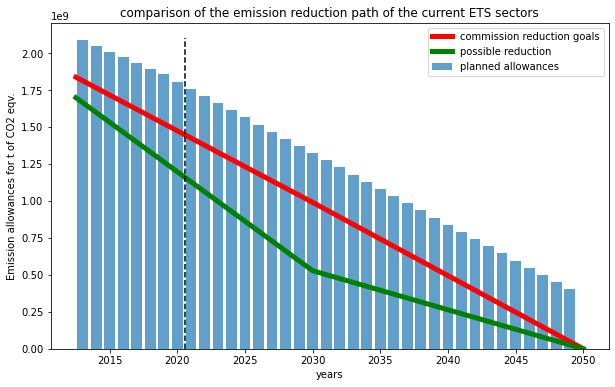Photo: SD-Pictures | Pixabay
Guest Author: Benedikt Heyl
Benedikt Heyl is a climate activist with German Zero, developing a concrete plan to make Germany climate neutral by 2035. He is a member of the Green Youth in Germany and studies theoretical physics at the University of Amsterdam.
The damages that the release of greenhouse gases causes to society as a whole are in crass contrast to the little repercussions that polluters experience for emitting them. To close this gap the European Emissions Trading System (ETS) was formed. Owners of selected point sources of CO2, N2O and PFCs have to get their hands on a sufficient number of emission allowances. The total emissions are capped and can be traded between interested actors. Right now, this broadly covers direct emissions from industrial sources and flights that don’t leave the EU. All in all, 40% of the total greenhouse gas emissions of the EU member states are affected. For all the problems that have plagued and still plague this measure, it has proven to be an effective tool. Emissions from the installations that were covered under the ETS declined by 35% in just 15 years. This is impressive for a measure that is not only free but actually generating hundreds of millions of euros that are being spent on research into low-carbon technologies.
Given the general 5 past 12 vibes in environmental policy, this sounds like the magic wand we so desperately need right now. Unfortunately, our usage is lacking in vigor. The massive emissions from transportation, agriculture and domestic heating are not or only partially covered by the ETS. A large number of certificates is still allocated for free to selected industries. Finally, the cap on emissions is not in line with the ambitions that the EU agreed to in Paris.
The Commission is to propose changes to the ETS sometime this summer. Here are a few ways to right the wrongs:
The obvious starting point is to include what is supposed to be included. This starts with emissions from fossil fuel-powered transportation applications. The least complicated and loophole-free way to do this is to require emission certificates when selling fossil fuels. This relatively simple intervention would cover gasoline, diesel or kerosene used in the transportation industry. Additionally, it would cover gas or oil used for heating. The only other source of greenhouse gas that can be attributed to a single actor is agriculture. Keeping track of the exact emissions of livestock and farmland requires a lot of work. Making farmers comply with another set of restrictions on top of the complexity that is the monitoring process of the Common Agricultural Policy (CAP) would be a bureaucratic monstrosity and rightfully make people angry at “Brussels”. The ETS is just not the best tool to reduce emissions in agriculture, since a proper reform of the CAP would give plenty of opportunities to financially incentivise sustainable farming practices.
“Given the general 5 past 12 vibes in environmental policy, this sounds like the magic wand we so desperately need right now. Unfortunately, our usage is lacking in vigor.”
Assuming the emissions caused by fossil fuels have to be accounted for by emission allowances, most of the direct emissions of greenhouse gases would be included in the cap and trade program and we could ensure that our emission targets in the relevant sectors are actually met. The Commission has stated that it wants to be climate neutral by 2050 and reduce emissions by 55% until the year 2030 compared to the emission of 1990. This commitment is insufficient. But arguably even worse is that it was put in place without any teeth. Right now, the emissions reduction path planned by the ETS is missing its mark and it is not particularly close. Only if this gap is closed and the number of allowances is reduced in line with these markers, we can treat these declarations as anything more than a suggestion.

Data for the plot: Revision for Phase 4 EU commission, Raising the EU 2030 GHG Emission Reduction Target UBA
Limiting the number of available allowances even more than is the case right now raises their price. This poses the danger of passing the bulk of the financial burden on to parts of society that cannot and should not be taxed any further. While we can raise the prices on driving your car quite quickly, making public transport options available takes time, especially in rural areas. That is why a significant number of people will continue to drive their combustion-powered cars out of a lack of alternatives. A fair reform of the ETS needs to include an adequate system of compensation, be it through the rural development fund or through direct payments. This is why the constraint that income generated through the sale of allowances can only be used to fund low carbon technology research needs to be lifted.
Another problem that needs to be addressed is the issue of carbon leakage. A globalised free market washes out any cap and trade system if the allowances are only required locally. Making pollution in the EU more expensive would only cause European companies to shut down and/or move overseas. To be clear this is only a problem in some industries. Cement, for example, is too heavy to be imported from far away. A person driving their car to work within the EU can also hardly outsource their mobility to a coal-powered wagon outside the EU. Because of the massive scale of the ETS, this is not a dominating issue; there is room to move. Nevertheless, to ensure that emissions are actually avoided and not just moved to other countries, a border tax adjustment would be necessary. This would require the actors importing into the European Economic Area to pay a border tax equal to the cost that they saved by not buying any emission allowances in the first place. Exporting actors on the other hand would be rewarded the higher production cost that they incurred when acquiring the allowances.
“Relying on the democratically flawed and secret legislation process of the EU without supervision from the streets is naive.”
This border tax adjustment is not perfect. It is complex since calculating the precise carbon footprint of trafficked goods is in the end, not possible and some faulty taxation is bound to happen. Yet fundamentally such an adjustment would protect the incentive that a stiff price on pollution creates inside the EU. The duties proposed here could also be lifted when trading with countries that are not part of the ETS but have put in place a Paris-compliant cap and trade system themselves. Granting access to the European market under this condition could become a powerful tool for establishing aggressive climate policy all over the globe.
Similar to the negotiations about the CAP we can’t expect good climate policy to be enacted when nobody cares while it is being debated. Relying on the democratically flawed and secret legislation process of the EU without supervision from the streets is naive. When the activism kicks in days before the parliament goes to vote and after having heard nothing but lobbyists talk for the last few months, the option that would keep our ecosystem intact suddenly seems out there. It is therefore paramount that we talk about the reform of the ETS as the central issue in European climate policy that it is. If the initiatives mentioned above are the ones that kick off the debate, then the people in favor of the dumpster fire that is the status quo will have to defend why ambition should be reduced and not the other way around.
Correspondence address: benedikt.heyl@googlemail.com

